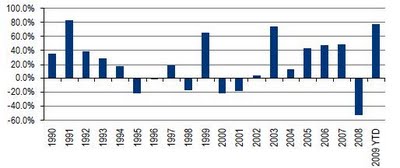 The year 2009 has turned out to be a big surprise. It is on track to be the best year for markets
The year 2009 has turned out to be a big surprise. It is on track to be the best year for markets
since 1991. [ 1991 and 2009 are Manomohan Magic Years ]
[ 1991 and 2009 are Manomohan Magic Years ]
The year 2010 is expected to be a year of consolidation rather than the “boom-bust” years in the past. The last time we ended a year with a single digit move (either positive or negative) in the market was in 2002 and 2004 was the last year with a move of under 25% in the markets.
The Good for Equities:
Global liquidity is likely to stay easy for an extended period of time. The Indian economy is recovering and we expect GDP to grow at 7.8% in FY11 vs. 6.2% in FY10. Earnings growth is likely to recover to over 20% in FY11 compared to 5% in FY10.
The Bad / Ugly for Indian Market:
Inflation can hit 5% by December 2009E and get close to 8% by March 2010E. Rising inflation has historically been negative for markets. Since 1990, there have been 7 occasions when inflation turned upwards. In 5 of these 7 occasions, markets have given a negative return in subsequent periods.
The RBI has already been sending signals on a possible exit policy. A rise in inflation will likely lead to a CRR/repo hike in January. And finally, stimulus withdrawal by the Government.
IPO / Paper Supply will Absorb Liquidity – supply of paper could be around $7-8bn including the PSU disinvestments.
Finally, Valuations are getting expensive though they are not yet in bubble territory. Markets are trading at 17x 1-year forward earnings ahead of 15x long term average.
Sensex Targets:
If the easy liquidity conditions globally lead to an asset bubble, we could get equity markets hitting the old highs. However, the markets will sustain at these levels in 2010.
Going by History, on the 2 occasions that market had fallen more than 50%, it took 294 and 571 days to hit the old peak. This means we should hit the peak between May 2010 and June 2011. Interestingly, on both these occasions, the markets gave a 30-40% negative return in the next 6 months.